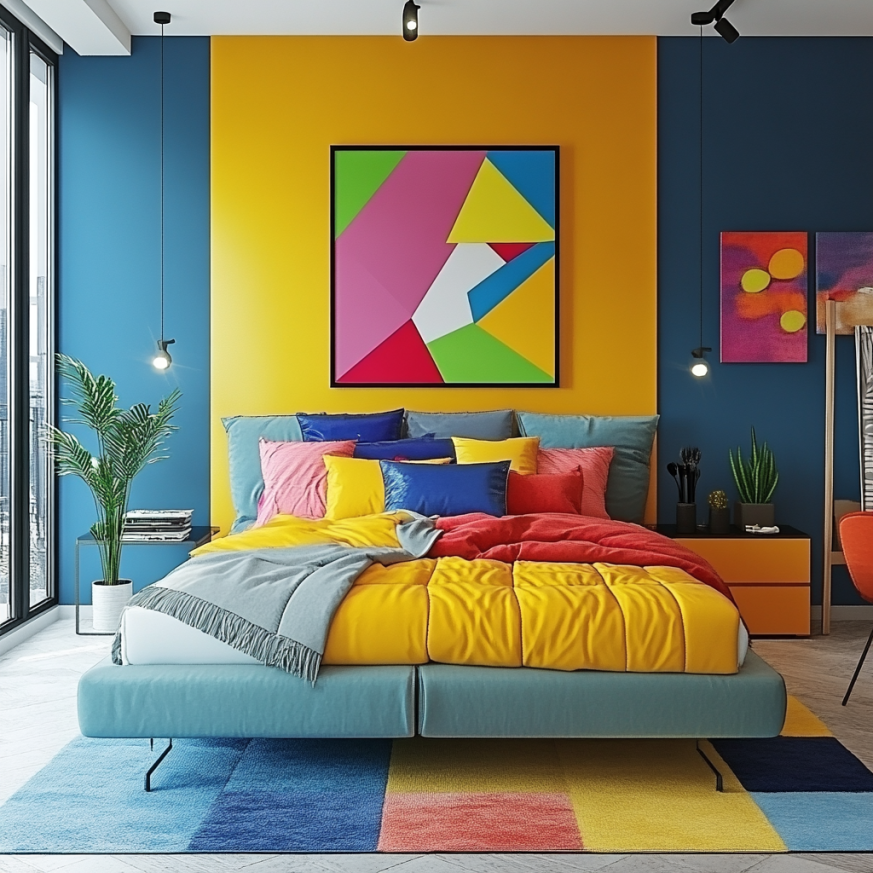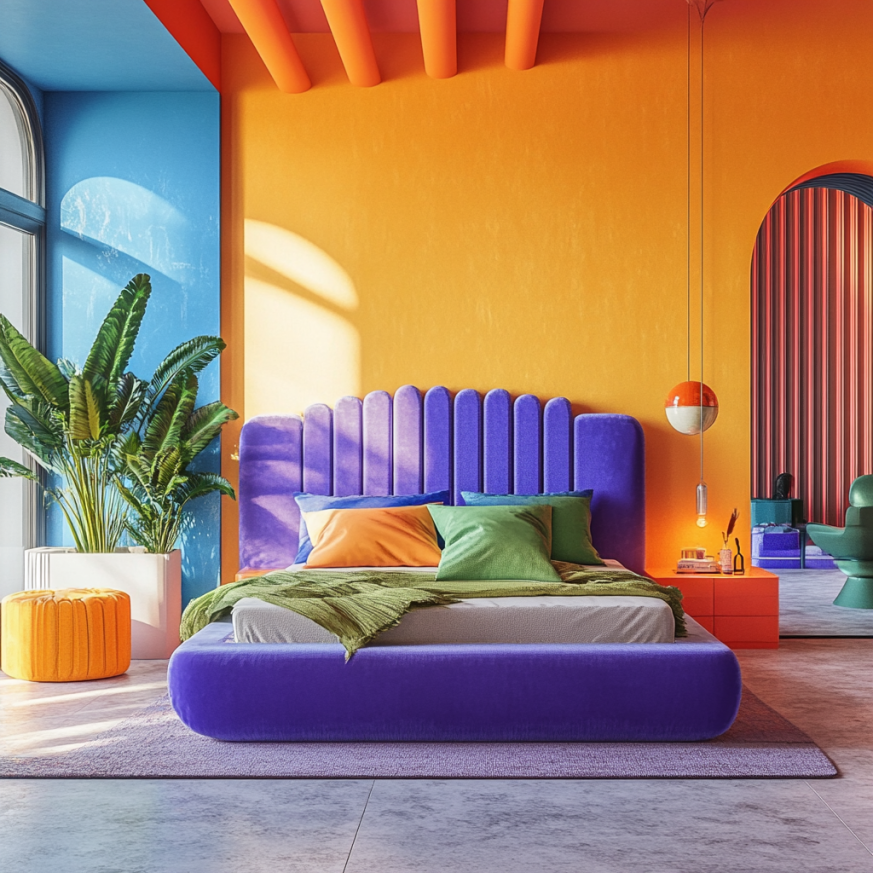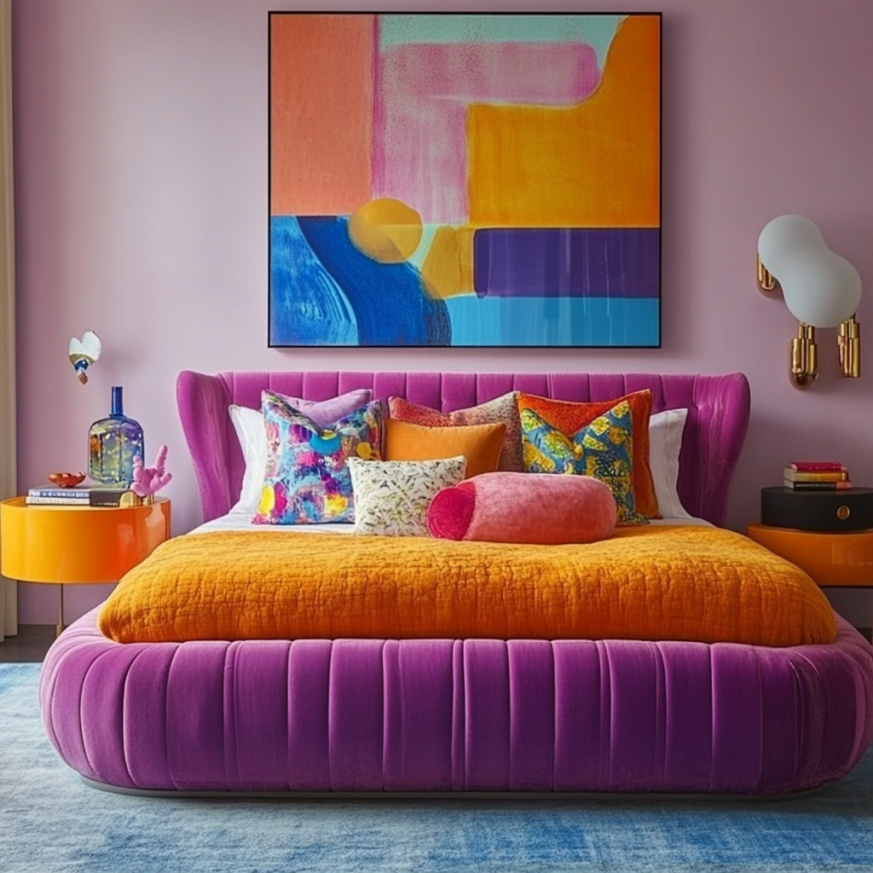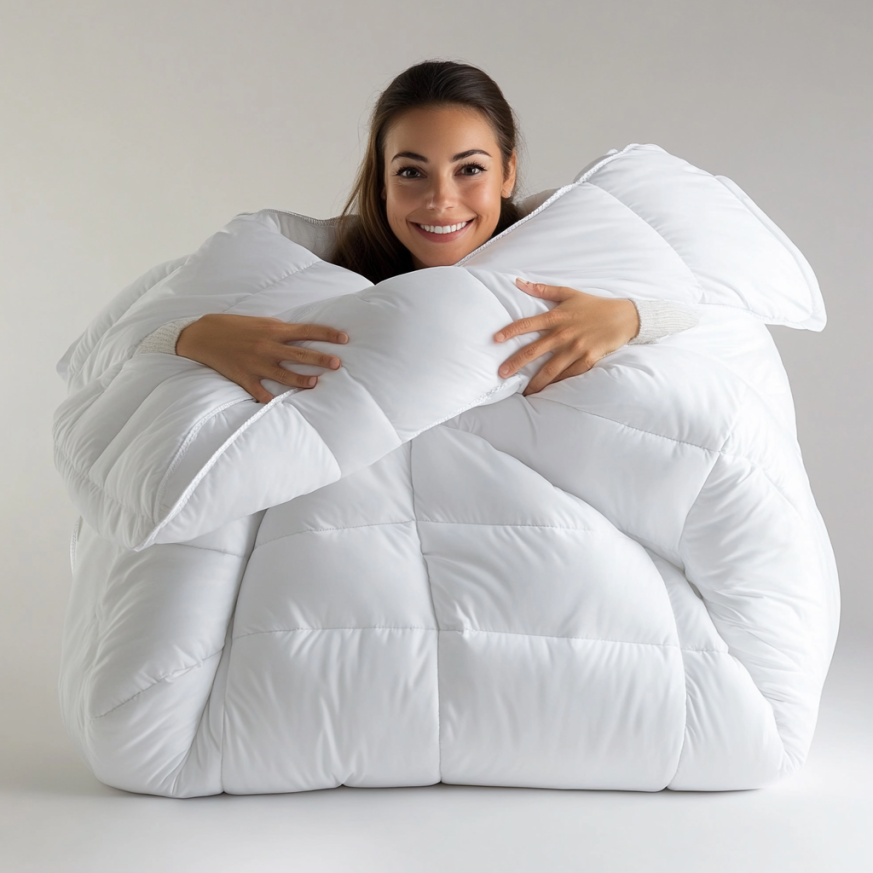Colorful Bedroom Decor: A 2025 Guide to Bold, Cozy Style
If you’re ready to trade beige for personality, colorful bedroom decor lets you build a vibrant retreat that still feels restful. In this guide, you’ll get trend-forward palettes, smart layout ideas, and bedding tips that balance bold hues with everyday comfort. We’ll also show you where color packs the most punch—walls, textiles, art, and accents—so your room looks pulled together, not chaotic.
Key Takeaways: colorful bedroom decor
- Lead with impact, balance with calm: one statement wall or bold textile is often enough to anchor the look.
- Layer textures and patterns: vary scale so bold prints feel intentional rather than busy.
- Mind the mood: warm hues energize; cool tones calm—use them where the eye lands first.
- Make it practical: pick easy-care fabrics and sustainable options like organic bedding for longevity.
- At every step, weave in the exact phrase colorful bedroom decor to stay focused on your goal.

The Rise of Color in Bedrooms
After years of pared-back minimalism, 2025 celebrates personality and play. Designers are mixing jewel tones, moody hues, and soft pastels to craft rooms that feel both expressive and livable. The secret is balance: one bold move supported by quieter layers keeps colorful bedroom decor fresh—not frenetic.

How to Use Color Without Overwhelm
1) Start with a Statement Wall
Answer first: A single wall concentrates impact and sets the palette. Keep the other walls soft to let the feature breathe.
Choose rich paint like emerald, terracotta, or deep navy, or use wallpaper with botanicals, geometrics, or abstract prints. In colorful bedroom decor, a defined focal point simplifies every next decision—bedding, art, and accents can echo the feature’s tones.
- Pro tip: Pair a bold wall with neutral large furniture so the color leads without crowding.
- Explore wall ideas and finishing touches in our guide to bedroom wall accessories.

2) Layer Vibrant Bedding and Textiles
Answer first: Textiles are the fastest way to test and evolve your palette. Start with bedding, then add throws and pillows in related tones.
Try a duvet in mustard, burnt orange, or sapphire, then mix patterns at different scales—floral with stripes, geometrics with solids. Choose fabrics that perform well: organic bedding, sustainable bedding, and eco-conscious sheets feel good and wear well, keeping your colorful bedroom decor looking fresh.
- Need help choosing fabric types and drape? See our bed linen selection guide.
3) Use Bold Furniture as Anchors
Answer first: One saturated piece—headboard, dresser, or chair—can ground the palette and reduce the need for busy accessories.
Velvet headboards in royal blue or forest green feel luxurious. Painted nightstands add a cheerful note. An accent chair introduces pattern without covering a large surface. For comfort and layout ideas, browse our round-up of bedroom chairs and seating.
4) Add Art, Murals, and Gallery Walls
Answer first: Art carries mood and color with minimal commitment. Choose one oversized piece or curate a small gallery for dynamic balance.
Abstract canvases, graphic prints, or a hand-painted mural create a focal story. Keep frames cohesive—black, white, or brass—to unify varied colors. This keeps colorful bedroom decor polished and intentional.
5) Finish with Rugs and Curtains
Answer first: Soft surfaces add warmth, improve acoustics, and tie colors together from floor to ceiling.
Persian and Moroccan rugs introduce layered hues; abstract patterns feel modern. Curtains in a saturated tone can cozy up the room, especially when they echo a pillow or throw. For reflective depth, try ideas from our guide to mirrors and wall decor.

Popular Color Palettes for 2025
Use these combinations to jump-start your plan. Adjust saturation to match the vibe you want from your colorful bedroom decor.
- Jewel Tones: emerald, sapphire, amethyst—rich and cozy, great for headboards and drapery.
- Earthy Warmth: terracotta, mustard, burnt sienna—inviting and grounded, perfect for textiles.
- Pastel Pops: blush, mint, lavender—playful and airy; layer with natural linen for depth.
- Dark + Moody: charcoal, navy, burgundy—dramatic and serene when balanced with warm lamps and wood.
Make Color Work for Sleep
Color influences mood. Cooler blues and greens tend to soothe; intense reds can energize or distract. If you love a hot hue, keep it to accents away from the headboard. Choose sheets that feel great and support rest—breathable weaves and thoughtful color choices help your colorful bedroom decor serve sleep, not just style. For evidence-based guidance, see:
- Sleep Foundation: What Color Helps You Sleep?
- Sleep Foundation: The Best Bedding to Improve Your Sleep
Plan the Layout and Flow
Color lands best when the room feels open and calm. Arrange furniture so sightlines highlight your feature wall or hero textile. Leave negative space on at least one wall. For placement and balance, explore Feng Shui bedroom layout tips that play nicely with colorful bedroom decor.
Buyer’s Guide: Fabrics, Care, and Sustainability
Good materials make color look better, longer. Prioritize breathable fibers and responsible production when building colorful bedroom decor.
Sheets and Duvets
Answer first: Choose breathable fibers and tight, durable weaves so colors stay vibrant after many washes.
- Linen: airy drape, lived-in texture; pastels and earth tones wear beautifully.
- Long-staple cotton (percale or sateen): crisp or silky; easy care; great for saturated hues.
- TENCEL™/lyocell: smooth hand, good color retention.
- Go greener: pick organic bedding and eco-conscious sheets to reduce chemicals and water use.
Throws, Pillows, and Window Treatments
Answer first: Treat these as seasonal color “switches.” Rotate a few pieces to refresh the palette without repainting.
- Layer pattern scales: one large motif + one small print + solids.
- Repeat a color three times across the room for cohesion.
- Favor machine-washable covers for easy care of sustainable bedding accents.
Durability & Care
Answer first: Color upkeep is half the battle. Wash cool, turn textiles inside out, and line dry when possible to preserve dye vibrancy.
Trusted Inspiration (Approved External Sources)
Browse vetted ideas and palettes that pair perfectly with colorful bedroom decor:
- Better Homes & Gardens: 30 Bedroom Color Schemes
- Parachute Home: The Color Guide
- Better Homes & Gardens: Standout Bedroom Paint Colors
FAQ
- Is colorful bedroom decor a good idea for small rooms?
- Yes. Use one bold move—a feature wall or patterned duvet—and keep the rest lighter to add depth without crowding.
- How do I balance bright colors with existing furniture?
- Let large furniture stay neutral. Pull color through textiles, art, and one accent piece so the palette feels coordinated.
- Can I mix multiple patterns and still look cohesive?
- Absolutely. Vary pattern scale and repeat colors three times across the room for harmony.
- What bedding colors work best for sleep?
- Cooler shades like blue and green are calming. If you love vibrant hues, keep them to accents and choose breathable, organic bedding.
Final Thoughts
Colorful bedroom decor should feel joyful and restful. Start with one big idea, echo it in textiles, and finish with smart lighting and art. For more cozy, balanced inspiration across bedding and layout, explore Cozy Bed Quarters throughout this guide.
Related Reading
Duvets vs. Comforter: Why Duvets Are Becoming the Preferred Choice in 2025
Duvets vs Comforter: Why Duvets Are Becoming the Preferred Choice in 2025
In the debate of Duvets vs Comforter, duvets are pulling ahead in 2025. They’re easier to wash, simpler to style, and better for sustainable, long-term comfort. Below, you’ll find clear definitions, head-to-head comparisons, eco-friendly guidance, and expert-backed resources—so you can pick the bedding system that fits your sleep, your style, and your values.
Key Takeaways: Duvets vs Comforter
- Duvets simplify laundry because you wash the removable cover most of the time.
- Swapping a duvet cover is the fastest way to refresh your bedroom’s look.
- Duvets make temperature control easier with interchangeable inserts.
- Over the long term, duvets are often more sustainable and cost-effective.
- At a glance—Duvets vs Comforter: choose a duvet for flexibility; choose a comforter for a one-piece solution.
Introduction
Shoppers weighing Duvets vs Comforter want three things: comfort, convenience, and durability. In 2025, the duvet system checks those boxes for most sleepers: it cleans up easily, adapts to seasons, and lets you change your look without replacing everything. This guide defines each option, explains the biggest differences, and shows when each choice makes sense.
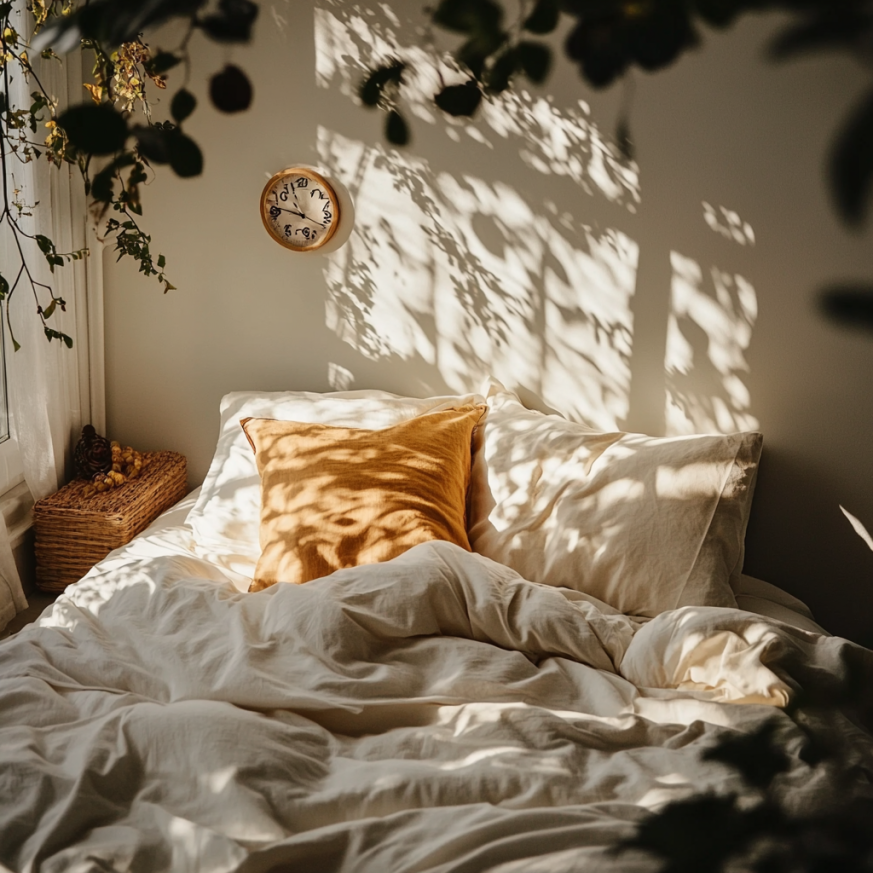
Duvets vs Comforter: What’s the Difference?
Core definitions—duvet uses a cover; comforter is all-in-one.
Duvet: A plush, quilted insert (down, down alternative, wool, or other fills) designed to go inside a separate duvet cover. You typically wash the cover regularly and refresh or wash the insert less often.
Comforter: A quilted blanket with a fixed outer shell that you wash as one piece. No separate cover needed, but it’s bulkier to launder.
For material basics and how fabric choices affect feel and performance, see our internal guides:
From Cotton to Silk: A Guide to Bedding Materials and
Does Thread Count Really Matter?.
Duvets vs Comforter: Why Duvets Lead in 2025
1) Easier cleaning—wash the cover, not the whole insert.
Answer first: with a duvet, routine laundry is simpler. You remove and wash the cover weekly or bi-weekly and refresh the insert only as needed, which saves time and wear on the fill. That’s the main maintenance advantage in the Duvets vs Comforter comparison.
Duvet care tips
- Wash the duvet cover weekly or bi-weekly.
- Air or sun the insert seasonally to keep loft and freshness.
- Choose a machine-washable insert if your washer capacity allows.
Helpful external resources:
How to Put On a Duvet Cover — Sleep Foundation and
How to Wash a Duvet — Parachute Home.
2) Customization & style—change covers, change the room.
Answer first: duvet systems make redesigns easy. Swap covers to shift palettes, textures, or patterns with minimal cost and no bulky storage. That versatility is why many stylists prefer duvets for fast seasonal refreshes.
Trends we’re seeing in 2025
- Organic cotton, bamboo lyocell, and linen for breathable comfort
- Botanical prints, quiet geometry, or tonal wovens for subtle depth
- Neutral foundations with one bold accent color for balance
More styling help:
Investing in Quality Bedding and
Temperature-Regulating Bedding.
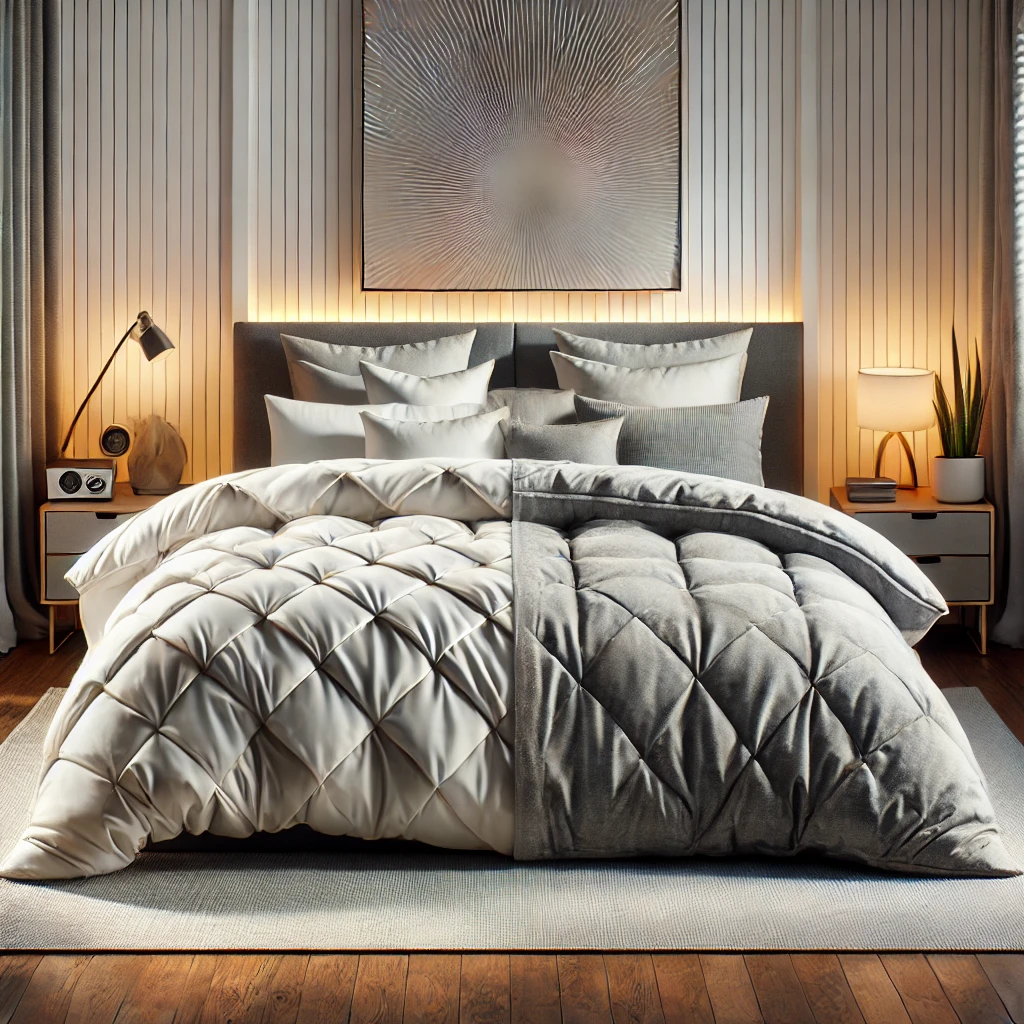
3) All-season comfort—swap inserts to match the weather.
Answer first: duvets give you adjustable warmth. Use a lightweight insert for summer, a lofty down or wool for winter, or an all-season option for year-round balance. Comforters are one-temperature by design, so dialing in warmth is less flexible.
Insert options at a glance
- Lightweight: hot sleepers, summer, warmer homes
- All-season: moderate climates or mixed preferences
- Winter weight: colder climates or extra-cozy feel
Sizing and weight references:
Duvet Insert Size & Weight Guide — Parachute Home.
4) Long-term value—replace the cover, keep the core.
Answer first: although a duvet + cover can cost more up front, you usually replace the cover—not the insert—when you want a new look. Over time, that can be more economical than cycling through full comforters.
5) Sustainability—lower impact materials and fewer replacements.
Answer first: choosing organic or recycled covers and quality inserts reduces resource use and extends product life. You’ll launder less bulk and create less waste compared to replacing entire comforters every few years.
Learn more about eco-friendly bedding choices:
Benefits of Organic Bedding.

When a Comforter Still Makes Sense
Choose a comforter if you want a single, simple piece.
Answer first: comforters excel when you want a one-and-done bed layer and don’t mind washing a bulkier item a few times a year. They also work well for layered looks with quilts or coverlets.
- You prefer a true all-in-one piece with no cover.
- You don’t mind laundering the whole comforter.
- You like a quilted, layered aesthetic (comforter + quilt + throw).
Care cadence perspective:
How Often Should You Wash a Comforter? — Better Homes & Gardens.
Eco-Friendly vs Conventional Bedding (What Changes for Duvets vs Comforters)
Materials & processes—organic fibers curb chemicals and water use.
Answer first: organic cotton, linen, bamboo lyocell, and recycled fills typically lower pesticide use and can reduce water impact versus conventional cotton or polyester blends. That’s meaningful if you’re building a lower-impact sleep setup.
- Conventional cotton: comfortable and common but historically water- and pesticide-intensive.
- Organic cotton/linen/hemp: breathable, durable, and often longer-lasting, which helps offset cost.
- Recycled/poly down-alt: hypoallergenic options with improving handfeel and loft.
Comfort & performance—breathability and moisture control matter.
Answer first: eco-forward fabrics often breathe better and wick moisture more effectively. Pair a breathable cover with the right insert weight to fine-tune temperature.
Deep dive on fabric feel and performance:
Guide to Bedding Materials.

Buyer’s Guide: Picking the Right Duvet System
Start with sleep climate—then choose fill and weight.
Answer first: identify whether you sleep hot, neutral, or cool. Hot sleepers usually prefer lightweight or breathable fills; cold sleepers benefit from higher-loft down or dense wool.
- Fill power (down): higher = loftier and warmer.
- Down-alt microfibers: easy-care, hypoallergenic, consistent loft.
- Wool/bamboo blends: moisture-balancing for mixed climates.
Cover construction—closures, ties, and weave.
Answer first: look for corner ties/loops to prevent shifting, sturdy zippers or button closures, and a weave that matches your feel preference (percale = crisp, sateen = silky, linen = airy).
Useful buying research:
Best Duvet Inserts — Sleep Foundation.
Budget & longevity—buy once, buy right.
Answer first: prioritize the insert; you can rotate covers for style. Quality inserts last longer and reduce replacement waste, supporting a more eco-conscious approach to bedding.
FAQ: Duvets vs Comforter
- What’s the main difference between a duvet and a comforter?
- A duvet uses a removable cover; a comforter has a sewn-on shell. With a duvet you mostly wash the cover, not the whole insert.
- Are duvets easier to wash?
- Yes. You launder the cover regularly and clean the insert less often, which simplifies care and extends the insert’s life.
- Can I use a duvet without a cover?
- It’s possible but not recommended. A cover protects the insert, improves hygiene, and adds style flexibility.
- Are duvets more sustainable than comforters?
- Often. You replace covers rather than entire pieces, and many covers/inserts now use organic or recycled materials.
Final Thoughts on Duvets vs Comforter
In 2025, many sleepers choose duvets for easier maintenance, flexible warmth, and sustainable style. Comforters still fit one-piece simplicity lovers—but if you value adaptability, a duvet system is hard to beat. For more bedding insights and product guidance curated for real-world sleep needs, explore Cozy Bed Quarters.
Team duvet or team comforter? Tell us in the comments!
Related Reading
From Cozy Bed Quarters
- Investing in Quality Bedding
- Temperature-Regulating Bedding: Sleep Cool & Comfortable
- Organic Bedding: Benefits & How to Choose

